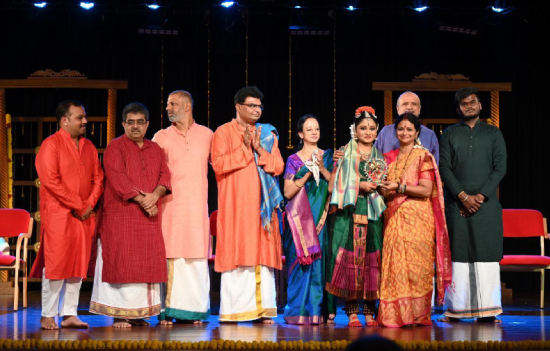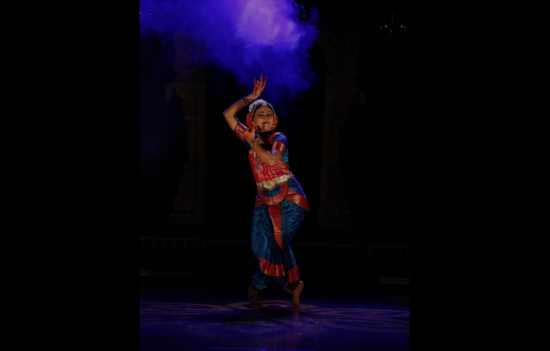- A very interesting and
stimulating conversation between two young dancers on their journey to Arangetram,
what it meant to them, its impact on their lifestyle and their future plans.
Authors are disciples of
Karnataka Kalshri Dr. Padmaja Suresh.
Aarya and Sreya are
students of Dr. Padmaja Suresh, Director of Aatmalaya Academy. They both
recently completed their arangetrams and are discussing their journeys and
future aspirations regarding the art form over a cup of coffee after a practice
session.
Sreya: So Aarya, it’s been just over a year since you completed your Arangetram! How do you feel now and how did you feel back then?
Aarya: We’ve been training for a year for our Arangetrams and back then nearing the day it was all about giving that final push. I just couldn’t wait for that day to arrive after months of effort and hard work. On that day it felt surreal as it was something I had been dreaming of for a very long time. Even after it was over, I truly felt no matter how tired I was, I would do the entire performance all over again. Now it is just a feeling of fulfilment. Arangetram is a huge milestone in any dancer’s career and I believe it has shaped us into who we are today.
Aarya: Recently, you completed your Arangetram too on May 25th, this year. How do you feel about that?
Sreya: Yes! Like you said there has been nothing more fulfilling than completing this for me. It’s my biggest program till date. There have been so many changes in my day-to-day activities, my discipline and even the way I used to train for dance has really changed. Each program I did during the span of my training, I could see significant changes and felt I was doing better each performance.
All of this is genuinely thanks to our Guru, Dr. Padmaja Suresh, who stood by us throughout. It wouldn’t have been possible without her guidance. It is something I truly will never forget.
Aarya: Yes, indeed, it requires discipline and commitment especially to take this up. You were talking about certain changes you noticed and I too have felt that in some way or the other this training has influenced my lifestyle whether it was through academics or daily habits.
How
were you able to incorporate such values into your lifestyle?
Sreya: Well, I learnt a
lot from preparing for the Arangetram but I think what stood out to me the most
was Discipline. I didn’t want to take my focus away from dance but I also slowly learnt how to balance my college schedule, exams, studies and dance. It taught me a lot about prioritization and sacrifice too. I have consciously started eating
healthy as well! These are just a few to name…what about you?
Aarya: Definitely feel the same way. I was just starting 10th grade and through the past year my biggest takeaway was to focus and consistency. There’s a lot of pressure when it comes to the Board exam but with prior guidance I had learnt to remove distractions and focus on the task at hand which reduced tension ten-folds and eventually helped me ultimately score better!
So, dance isn’t just about being physically fit, but mentally fit as well.
Sreya: Absolutely…We both started dancing at a very young age and it’s been 8 years since we joined Aatmalaya. It’s quite evident how much dance means to us and what a huge part of our lives it has become.
Sreya: I also wanted to talk about the Pooja we do to our Gejje
(also called Ghungroos or Chalangai) 60 days before the Arangetram. What was
that like for you?
Aarya: I really felt that while doing the pooja every day I learnt what it really means to commit to something that has the power to change your life for the good.
That pushed me to
understand the music, Talas, Ragas and made me realize that while dancing the
Bhava, Rasa, Abhinaya should come from the heart. That is what makes one a good
dancer.
 Dr. Padmaja Suresh and musicians.
Dr. Padmaja Suresh and musicians.
Sreya: I too really liked
that we were able to devote ourselves to this and the Lalita Sahasranama. It
made me feel connected. Even just before the Arangetram when our Guru gave the gejje, there was a sense of immense
happiness and joy that I am still not able to describe.
Aarya: I agree. Coming to the Arangetram, what does that truly mean to you?
Sreya: Theoretically,
Arangetram is split into two words, Arangu
and Ettam which is mentioned in the
Tamil book: Sillapaddikaram. It literally means ascending the stage. However,
not many people know about the significance of Arangetram and how important it
is in the journey of a dancer.
 Sreya with her Guru and musicians on the day of her Arangetram.
Sreya with her Guru and musicians on the day of her Arangetram.
Aarya: Definitely! For the dancer, Arangetram is:
A
culmination of years of discipline, dedication, and devotion, a moment of
gratitude to the guru, family, and deity and the beginning of a lifelong
journey with art. Our Guru provided us with many opportunities as students of
Aatmalaya.
I still remember our first performance together for Aatmalaya’s annual festival - Shri Chakra Raja. She continues to give
us so many opportunities. Like how I taught at Government schools as a
workshop. It was a new experience for me and I learnt so much from this. It was
great fun meeting new students whose keen eyes inspired me to take up this art
even further.
 Aatmalaya archives collection (Photos by EGK and sons).
Aatmalaya archives collection (Photos by EGK and sons).
Sreya: You’re right. For me it is a huge achievement too. I was able to share with my family and loved ones this art form on stage, an art which has been passed on from a lineage of Gurus.
This is the Guru-Shishya Parampara our Padmaja ma’am has always stressed upon and instilled in us.
Sreya: Very true. Tell me
about some of your compositions from your Arangetram and which of them was your
favourite?
Aarya: The first piece was on Lord Ganesha, as he is the remover of all obstacles. For this, I performed Ganesha Kavuthuvam. Kavuthuvams are an invocatory piece performed as daily worship at temples, particular to the Tanjavur Bani.
Next, we had two pieces
in my mother tongue Kannada. These were Gajavadana
Beduve and Shringapura Deeshwari
Sharade. My favourite pieces have to be Sarasijakshulu
(Krishna Shabdam) and of course, Hanuman
Chalisa. But, I also really love Varnam
(Devar Munivar).
 Aarya in pose of Lord Krishna (Photos by Rakesh VC).
Aarya in pose of Lord Krishna (Photos by Rakesh VC).
 Poses from Aarya’s Arangetram.
Poses from Aarya’s Arangetram.
Aarya: Could you explain a bit about the concept of your Arangetram and its meaning?
Sreya: So the concept
behind my Arangetram was Shanmaata,
based on the six deities of Ganesha, Skanda, Shiva, Devi, Vishnu and Surya as conceptualized
by Jagadguru Adi Shankaracharya, who believed it to be the path to Brahman.
It started off with
Gayatri shlokas for all six deities followed by a kriti on Lord Ganesha in Telugu - Sri Ganapatini. The second piece was an Allaripu with salutations to Surya. It was in Khanda jathi ‘Atta’ tala, which makes it quite different from the Allaripus we have learnt before. It was fused with Surya ‘anga’ pooja and Ata
Dwaadasha Nama (twelve names of Surya) which you would’ve heard during Surya Namaskara.
Aarya: That was truly a delight to watch. Something we don’t see very often in Arangetrams, which is why I think it is such an advantage to have a Guru like Dr. Padmaja Suresh ma’am to guide us. The best part is that she not only teaches us how to dance but also performs and demonstrates herself. That helps understand better and motivates us to eventually make us dance better.
Sreya: True. Apart from just dancing, Padmaja ma’am also encourages us to read sacred texts and literature like the Natya Shastra and
Abhinaya Darpanam for deeper context
so we are equipped with theory as well.
Sreya: I have also noticed how each student’s repertoire is very different and personal as well. My mother tongue is also Kannada and I performed Toredu Jeevisabahude, a very famous composition by Kanakadasa. This
song was chosen by my Mother and she really loves it.
Aarya: That’s wonderful! Out of all the pieces you performed, which one would be your favourite? I have to say my favourite was Shankara Shrigiri!
Sreya: I really loved my
Varnam, Amma Anandadayini which is in
Telugu. It is about Devi and speaks about how she spreads happiness, grants
peace and blesses all. How she is always there and guiding us with her
everlasting presence. I think all of us have this attachment to our first
Varnam and I thoroughly enjoyed performing this on stage.
 Sreya in pose of Devi.
Sreya in pose of Devi.
 Poses from Sreya’s Arangetram (Photos by Vishwanath Anup- Temple Sounds)
Poses from Sreya’s Arangetram (Photos by Vishwanath Anup- Temple Sounds)
Aarya: I think we all have a feeling of attachment to our Arangetram repertoires as it marks a huge milestone in our lives and careers.
Sreya: So Aarya, what are
your plans for the future?
Aarya: I really want to continue learning new compositions, padam, javallis, etc and try to expand my knowledge and connect to my roots.
Sreya: Same here, I also want to keep performing whenever I get the chance, also I can't wait to get back to performing together!!!
Aarya: Yes, can’t wait!
To read all articles on Indian Dance Forms
According to an older student of Karnataka Kalshri Dr. Padmaja Suresh, “Ghungroos, the small metallic bells worn around a classical dancer's ankles, hold deep symbolic and practical significance. They serve as an extension of the dancer’s body, accentuating rhythm and footwork, and transforming movement into music. Beyond their auditory function, ghungroos are a sacred adornment, symbolizing a dancer’s commitment to the art form and their spiritual connection to tradition. The sound of the bells marks the presence of the dancer and the divine energy of the performance, making them an essential part of classical Indian dance.”
What is the importance of Gejje? (called Ghungroos
in North)